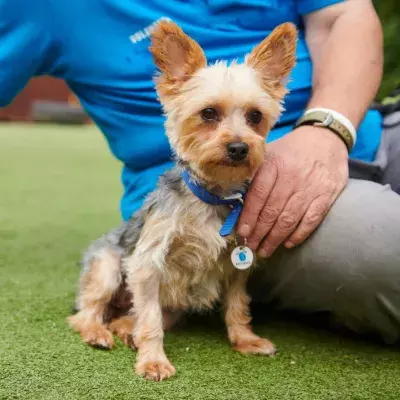Overstimulation refers to a range of behaviours that dogs display when they feel overwhelmed and are struggling to cope with certain triggers. Overstimulation often looks like excessive mouthing, jumping up, and tugging on clothes or the lead. Here is our guide to help you understand what often triggers overstimulation in dogs, and what behaviours you can train to help calm an overstimulated dog.

What is overstimulation?
Overstimulation usually occurs when your dog is overwhelmed and can’t cope with certain triggers in their environment.
Your dog could display a range of behaviours when overstimulated, including excessive jumping up, humping, mouthing, nipping, grabbing, and ragging on the lead, your clothes and other equipment.
When a dog is overstimulated, it can be hard to calm them down, and this can escalate to aggression if not dealt with appropriately.
How do I manage an overstimulated dog?
To manage overstimulation, you’ll first need to identify what is causing your dog to behave this way – for example, it could be other dogs, people or animals, or situations like busy roads or loud environments. It may help to take a few notes about the situation whenever your dog is overstimulated, so that you can identify what is triggering them.
Once you understand the cause of their behaviour, you can work towards avoiding excessive exposure to the trigger. The more they get the chance to practise the inappropriate behaviours, the more they’ll want to keep doing it.
When your dog is overstimulated, avoid distracting them with food as this could encourage them to repeat their behaviour.
Instead, try to build a positive association to the trigger. For example, if your dog doesn’t like being handled, this could trigger them to become overstimulated which leads to unwanted behaviours. When your dog is calm, practise building a positive association to being handled by rewarding them with a treat whenever you touch them.
What behaviours can I teach to help overstimulation?
When a dog becomes overstimulated, you’ll often find they are unable to listen and learn new things, so you’ll want to have some behaviours up your sleeve that your dog knows reliably, to use in emergency situations.
Impulse Control
Self-control doesn’t come naturally to dogs and is a skill that they need to learn. Impulse control is about teaching your dog to engage their brain and override their automatic response to a stimulus. Giving your dog mentally stimulating activities that are of low arousal will help to engage their senses and increase their overall level of calmness.
Getting Your Dog To Focus On You
When dogs are around distractions, they’ll have a ‘threshold’ distance where they’ll be able to show calm behaviours, take food and respond when we interact with them. If we cross this distance, they’ll be ‘over-threshold’ and no longer able to do those things. Monitoring your dog’s body language will help to understand when they are approaching their ‘threshold’. Over time, and with lots of practice, you should be able to expand your dog’s threshold and get them to remain calm in more stimulating situations.
How To Get Your Dog To Focus On You
Emergency Stop
An emergency stop is an important command for your dog to learn as it can be used in urgent situations that need immediate intervention.
For example, this could be used to stop your dog from running up to a potentially reactive dog, running across the road, or if your dog has become overstimulated. The command helps to get their focus back to you and can stop a situation from escalating.
Teaching Your Dog An Emergency Stop
Teaching Your Dog A ‘This Way’ Cue
‘This Way’ can be used to tell your dog that you’re changing directions and you want them to follow. This can be really helpful if your dog is a bit nervous, gets frustrated on the lead, needs to work on loose lead training, or becomes easily overstimulated.
Teaching Your Dog A ‘This Way’ Cue
Constructive Play
Play time is a great way for your dog to burn off some energy, and by engaging in constructive play, you can also use this time to teach your dog some polite manners. The most important thing to remember during constructive play is not to overstimulate your dog too much. We want them to be excited but not so excited that they aren’t able to respond to commands.
Once these behaviours are well practised and you are confident in your dog’s understanding of them, they can then be used in emergency situations. If your dog is still struggling with overstimulation, we recommend getting help from a qualified trainer or behaviourist.


